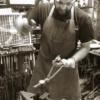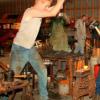-
Posts
125 -
Joined
-
Last visited
Contact Methods
-
Website URL
http://www.ontarioblacksmiths.ca/artist-page-david-brandow
Profile Information
-
Gender
Male
-
Location
Ontario
Recent Profile Visitors
-
Neil Blythin started following dbrandow
-

Blacksmithing gems and pearls
dbrandow replied to Glenn's topic in Blacksmithing, General Discussion
"Hit it like it owes you money" -
In my view, I'm not convinced there is a point in having a certification for an artist blacksmith, because there really isn't much in the way of requirements to fulfill. For bladesmiths, I'll buy the argument, you can define standards for what a knife should reasonably be expected to do that aren't something a layperson could be expected to detect. Similar, for a farrier, there are standards of care that a layperson could not detect. But what standards would you expect for a sculpture, or a window grille, or a hat stand, or scrollwork on a gate? Short of structural requirements, which is really the domain of engineers, everything else is something that the customer can detect for themselves. For the same reason, you wouldn't expect to see the certification of the person painting your portrait.
-

The Faggot Weld
dbrandow replied to brianbrazealblacksmith's topic in Blacksmithing, General Discussion
It strikes me that this can be boiled down as follows: - Is this weld structurally sound enough for the purposes of the tool being made? - The general consensus appears to be yes. - Is it structurally sound enough for forge welds that may be applied to more demanding applications? - Open for debate, shall we say. :P - If the answer is no (which I'll grant for the purposes of this post): - Is it appropriate to teach beginners a weld which, while simple to execute, may not be sufficient for their future needs? - In my opinion, the answer is yes, although I think it would certainly be fair to say that it would be in the best interest of the student to discuss the disadvantages of this type of weld. The rewards for a beginner of getting a successful forge weld, in my opinion, outweigh the potential downsides. If we were talking about training full-time blacksmiths, perhaps not, but in 95% of cases we're talking about training hobbyists at best. -

What is everyone charging for Roses?
dbrandow replied to Dogsoldat's topic in The Business Side of Blacksmithing
If you are planning on making more than a couple, do yourself and order the blanks from a company that does laser cutting (or something similar). As an example, it costs around $7 to get the blanks made around here, and the amount of time you save versus chiseling makes that well worth the investment. -

eastern ontario blacksmiths
dbrandow replied to Che Guevara's topic in Ontario Artisan Blacksmiths Association (OABA)
There will be an OABA meeting near Peterborough/Norwood on the second weekend of July, that's the closest we're scheduled to have in 2014. There may be other events further on in the year as well, check the website for more details as they become available. OABA would also be interested in helping to sponsor Eastern Ontario blacksmiths who wanted to get together for Hammer-In/Open Forge type meetings, feel free to contact me, or anyone else on the executive, for more details. We would also be interested in any Eastern Ontario blacksmiths who were interested/willing to host an OABA event. -

Another gas versus coal question
dbrandow replied to jdawgnc's topic in Blacksmithing, General Discussion
I'd like to quibble briefly with the notion that electric welding is necessarily faster than forge welding, particularly if its a piece you are currently working on in the forge. Forge welding: Preheat in forge (assuming it isn't already hot, which it typically is) Brush Apply flux Heat in forge Hammer together to get a tack weld Brush Apply flux Heat in forge Hammer together to complete the weld Electric welding: Grind to create clean surface (might need to cool it down first) Setup on welding table with vice(s) Turn on welder Take off glasses, put on helmet Weld Chip Brush Weld Take off helmet, put on glasses Turn off welder Grind to make it look somewhat presentable/Wrap with something so the weld isn't visible I'm not trying to start a long-winded argument here about the pros and cons of each, that's been done to death, but based on my admittedly limited experience, electric welding is quite often slower, not faster. -

Anvil size vs hammer size, 2% or 10:1 or 15:1
dbrandow replied to Glenn's topic in Blacksmithing, General Discussion
I suppose, but again, because it doesn't take into account what material the anvil is made out of, or the fact that it cannot move but instead can only compress, it doesn't seem to me to be taking enough of the real world variables into account to be a useful enough model. It might establish a lower bound, but it doesn't sufficiently answer the question at hand. If the equation in consideration, this or any other, doesn't take into account whether the anvil is made of mild steel, hardened tool steel or wood, then I can't consider it applicable enough to be of much value. A professional engineer wouldn't design a bridge without taking into very careful consideration what materials its made out of, the same thing applies here. -

Anvil size vs hammer size, 2% or 10:1 or 15:1
dbrandow replied to Glenn's topic in Blacksmithing, General Discussion
In the case of that specific analysis, I think I'm far more skeptical of the applicability of its findings to the real world question than I am to its contents, given how different the scenario it envisages are from the one we are actually using. -

Anvil size vs hammer size, 2% or 10:1 or 15:1
dbrandow replied to Glenn's topic in Blacksmithing, General Discussion
I completely agree with your point about using intuition in math/science, at least generally. But in some specific cases, I believe you can use intuition as a 'sniff test'. Believe me, I do understand 'equal and opposite reaction', but I also understand, in my non-physicist way, the difference between a perfectly elastic collision and the inelastic collisions we see in the macroscopic environment we are typically interested in. I suspect you are correct, that mass as a single factor is a poor indicator (although I'd be interested in seeing real math/physics that demonstrated this), but at the same time I'd be deeply suspicious of the notion that it has no effect whatsoever. -

Anvil size vs hammer size, 2% or 10:1 or 15:1
dbrandow replied to Glenn's topic in Blacksmithing, General Discussion
Quite obviously I wouldn't do that in reality, what I presented was a simple thought experiment meant to demonstrate that anvil size (and geometry) clearly do matter. -

Anvil size vs hammer size, 2% or 10:1 or 15:1
dbrandow replied to Glenn's topic in Blacksmithing, General Discussion
Again, intuitively that doesn't make much sense to me. Take a 100lb anvil, put it on a piece of rubber, now hammer a piece of hot steel on it. Repeat the experiment, but replace the 100lb anvil with a 1lb piece of 14 gauge steel. Think you'd have the same experience? Then anvil weight obviously matters, at least to some extent. -

Anvil size vs hammer size, 2% or 10:1 or 15:1
dbrandow replied to Glenn's topic in Blacksmithing, General Discussion
I am not a physicist, but I find myself skeptical of some of the physics and math that has been presented in earlier comments. Specifically, I am skeptical because it doesn't discuss the compressive strength of the anvil. The anvil isn't moving (assuming its anchored reasonably well), so the key factor is how much the anvil compresses underneath the blow (before returning to its original state), something that obviously isn't visually apparent. If we were to use some of the earlier formulas, a 100lb anvil made of rubber would behave the same way as a 100lb anvil made of steel, which is obviously ludicrous. The difference is that rubber compresses dramatically further under the same force than steel does. The mass and geometry of the anvil also matter, a 1lb 14 gauge piece of steel sitting on a piece of rubber will compress dramatically more under the same force than a 100lb steel anvil sitting on the same piece of rubber will. -

New Coal Supplier ???
dbrandow replied to Sam Falzone's topic in Ontario Artisan Blacksmiths Association (OABA)
Yes he is. link is 404 -
If you are able to, feel free to come out to an OABA meeting, its free to come out, you can talk with other blacksmiths, watch demonstrations, drink coffee and eat doughnuts, do some forging of your own and get some free advice and pointers, all kinds of good stuff. Our next meeting is February in Milton, check the website for details.
- 9 replies
-
- identification
- steel
-
(and 2 more)
Tagged with:
-

Too hot in the shop; how do you stay cool?
dbrandow replied to 78sharpshooter's topic in Blacksmithing, General Discussion
While I'm no expert, my wife works in an industry where they need to control heat and air flow in their buildings very carefully. The first thing to understand is that air won't flow out if there is no air to flow in to replace it, so having one opening in the building won't give you very much airflow. Think of a ketchup bottle, if you hold it directly vertical, it won't flow out very easily because there's no way for air to get in to replace it. Tilt the bottle on its side and it'll come out much easier. Having an opening on opposite sides of the building will make a big difference. The next thing to understand is why air flows. The first is a difference in air pressure, caused either by wind (which will be more effective if it lines up with the direction of those two openings) or by fans. The second is heat, hot air rises/cool air sinks, but only if it has a place to go, so you'll want a well-ventilated roof. If you can put a fan in the roof to blow the air up towards those vents, so much the better.


